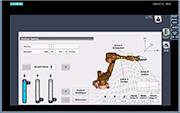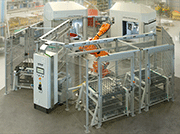E-Archive
Good Vibrations
in Vol. 18 - November Issue - Year 2017
Surface finishing moves to the center of the manufacturing chain. Automated Mass Finishing Processes Help Meet The Toughest Surface Specifications.

Photo 1: Old tumbling barrel from the 1950’s

Photo 2: Modern, automated inline continuous flow finishing vibrator

Photo 3: PLC touch panel showing robot teaching functions for a Surf-Finisher

Photo 4: Fully automatic deburring system for stampings at an automotive supplier

Photo 5: Finishing cell with two drag finishers and one robot for automatic loading/unloading of the work pieces

Photo 6: Fully automatic centrifugal disk finishing system including washing and drying of the finished work pieces

Photo 7: Automatic Surf-Finisher for deburring of "root" and "shroud" of low-pressure turbine blades
Today’s competitive manufacturing environment is characterized by increasing demands for quality improvement and lower costs. At the same time, customers across many industries, from aerospace, automotive, medical engineering or equipment building to consumer goods manufacturers (time pieces, cutlery, spectacle frames, etc.), are asking for significantly improved surface finishes of their work pieces. In many instances, it is not uncommon to see the surface finishing aspect of a component receive as much attention as the actual production step. Such challenges, along with demands for zero defect finishing operations, can only be met in a consistent and cost effective manner by automation!
From a backroom operation to a sophisticated finishing technology
Since its "invention" in the 1950’s, mass finishing has come a long way. While welcomed as an enormous improvement over hand deburring of simple, mass produced parts, for many years mass finishing was treated as an unloved, unappreciated, noisy and wet backroom operation (photo 1).
In recent years, this perception has drastically changed. With increasing demands for better surface finishes and the treatment of high value, geometrically complex and delicate components mass finishing evolved into a sophisticated surface treatment technology that is at the center of countless manufacturing processes. In many instances, mass finishing is the key stage in the manufacturing chain that adds the highest value to a product (photo 2).
Perfect surface finishes drastically improve the product quality
Nowadays we expect a car to run problem-free for hundreds of thousands of kilometers with excellent mileage. I remember how happy I was with my 1965 VW Beetle to run 100,000 km, before the engine had to be replaced. My 2005 VW Phaeton has over 300,000 km and is still running great. Today our risk of getting blown out of the sky by terrorists is higher than a crash caused by engine or fuselage failure in an airplane.
Besides improved materials, these improvements are largely due to better surface finishes. In cars, smoother surfaces reduce friction, allow lower operating temperatures, improve oil retention, i.e. lubrication, capabilities and, overall, extend the service life of components like engines, bearings, transmissions, etc. Similarly, in airplanes, smoother surfaces reduce airflow resistance and exhaust gas temperatures, thus reducing fuel consumption. Finally yet importantly, improved surface finishing greatly reduces the risk of stress cracks and premature component failure.
Automation produces high quality surface finishes at affordable costs
Automation is mostly associated with the displacement of people by machines. While the control of personnel costs is important, another even more important aspect of automation in mass finishing applications is its high process stability. By taking out the vagaries of the human factor, rejection rates are drastically reduced, and repeatability of the finishing results within very close tolerances is ensured. The overall result: Greatly improved surface finishes at considerably lower costs. Without automation, the progress in terms of better surface qualities, longer component life and reduced costs would have been unthinkable!
New equipment features, advanced material handling and sophisticated electronic controls facilitate automation
Partial automation of mass finishing processes has been common for some time. However, until very recently, fully automatic mass finishing systems were relatively rare and usually very expensive. This has dramatically changed: By incorporating numerous innovative features into their equipment and utilizing advanced material handling equipment along with state-of-the-art electronic controls, equipment manufacturers can now offer fully automatic solutions for practically any mass finishing application.
Just to name a few of these equipment features: Fully automatic gap adjustment in centrifugal disk finishing machines, self-cleaning undersize media separation screens, automatic work piece clamping systems in drag finishers, or automatic media top-up systems.
Special material handling systems like automatic roller conveyors, in combination with different types of hydraulic or mechanical loaders, vibratory hoppers, special conveyor belts, etc., allow the staging and automatic processing of work pieces for several shifts without any operator involvement. In addition, robots have increasing use for all kinds of material handling functions in mass finishing processes (photo 3).
Linking of all these different systems is achieved by highly sophisticated electronic controls. Bar code scanners trigger selection of the correct processing program in the system PLC. For production control purposes (just-in-time operation), the PLC can be linked to a higher-level master computer. Video cameras monitor the complete process and can trigger an alarm in case of deviations, for example, lodged media in a finished work piece. Moreover, process functions are automatically adjusted to changing operating conditions like increasing the compound dosing rate in case of more oil being carried into a mass finishing process.
With new technologies like additive manufacturing and demand for further quality improvements, surface finish specifications are likely to become even more stringent in the future. Only equipment manufacturers who fully embrace automation will be able to meet these challenges.
Some automation examples
The installations below are intended to provide a brief overview of the automation possibilities in mass finishing:
Deburring of stampings in rotary vibrators at an automotive supplier
The task: Fully automatic deburring/de-oiling of high volumes of small stampings.
The solution: The system consists of four rotary vibrators specially designed for magnetic separation. A lift & tip loader transfers the raw parts from the part bins into a vibratory hopper on rails. This shuttles to one of the vibrators and dumps the parts into the empty machine. After completion of the finishing process, a magnetic separator, also on rails, shuttles to the vibrator, removes the finished parts, and places them on a conveyor belt. At the end of the belt, a secondary magnetic separator picks up the parts and dumps them into a vibratory hopper. This ensures that no residual media is carried out of the process. The vibratory hopper transfers the finished parts into waiting part bins. All this takes place fully automatically.
Drag finisher with robotic loading/unloading of the work pieces at a tool manufacturer
The task: Fully automatic deburring/smoothing of a wide variety of tool bodies.
The solution: The system consists of two compact drag finishers equipped with six spindles; each spindle with special pneumatic docking system and precision positioning of the carousel. The raw parts are placed in special pallets with an accuracy of +/- 0.1 mm. The robot, serving both drag finishers, picks up the parts (one at a time) from the pallets and attaches them to the spindles. After process completion, the robot releases the pneumatic docking system to remove the finished parts and return them to their precise location in the pallets. The system requires no human intervention whatsoever.
Deburring of stainless steel disks and rings in a tandem centrifugal disk finishing system at a medical equipment manufacturer
The task: Deburring/edge radiusing/de-oiling of high volumes of small disks and rings.
The solution: The system consists of a fully automatic tandem double-batch disk-finishing system. The raw parts arrive in part bins. An operator dumps the parts from the bins into two special lift & tip loaders, which transfer them into two centrifugal processing machines. The empty bins are placed on a roller conveyor system at the end of the line. After completion of the finishing process, the complete batch of parts and media is dumped onto a vibratory screening system for separation of the finished parts from the media. From there, the finished parts are passed through a vibratory washing system and a rotary drier from where they are automatically backfilled into the waiting part bins. The operator function is limited to placing the raw parts into the system, positioning the empty part bins on the roller conveyor and removing the finished parts.
Deburring of "root" & "shroud" of low pressure turbine blades in a Surf-Finisher
The task: Targeted deburring of the "root" and "shroud" surface sections without affecting the airfoil section.
The solution: The system consists of a Surf-Finisher, 2 robots and a roller conveyor. The machined turbine blades arrive in special pallets on the roller conveyor from where they are picked up by the two robots – equipped with special grippers – and manipulated in the rotating media with pre-programmed movements. After deburring of the "root" and "shroud" is completed the robots return the finished turbine blades to their precise location in the pallets. The complete process can be monitored remotely via strategically placed video cameras at the finishing system.
Good Vibrations
by Eugen Holzknecht
Contributing Editor MFN and
Rösler Oberflächentechnik GmbH
E-mail: holzknecht.usa@gmail.com



























